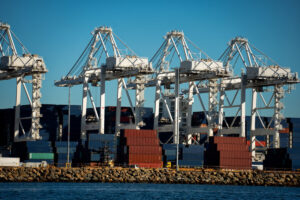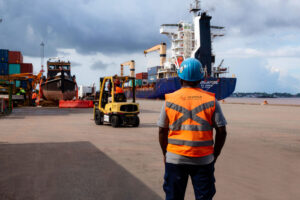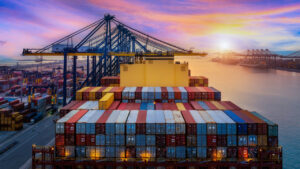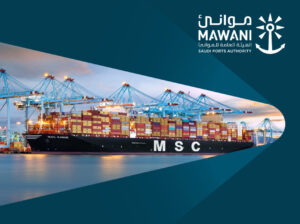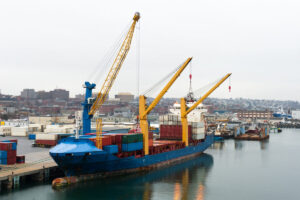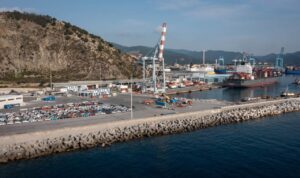Artificial Intelligence (AI) is one of the most exciting technologies in the industry and can be utilised in many different ways to improve operations and increase collaboration in ports and across the supply chain.
With this in mind, PTI continued its webinar series by focusing on ‘Artificial Intelligence and Resiliency’ and brought together some of the industry’s leading experts in the field of smart technologies and maritime.
The panel of experts looked at a range of these, including visibility and minisiming downtime, and the challenges to making the most of the technology, including the question around data and standardisation.
Missed the webinar? Catch up on all the presentations here.
In this latest webinar, Robbert Engels Director of Product, PortXchange (Port of Rotterdam), joined Dr Eva Salvesberg, Senior Vice President, INFORM Software, Dr Oscar Pernia, Director of Automation & Process Engineering, Terminal Investment Limited and Dr Csaba Boer, Chief Product Officer, TBA.
Shining a Light
Starting the webinar, Engels detailed how Artificial Intelligence (AI) is used at Europe’s busiest and most technologically ambitious port – Rotterdam.
He said AI is being used to “shine a light” on port operations and drive real value in shipping. Specifically, he focused on real-time visibility and how “high-quality” can be shared between actors beyond the port. Such actors include pilots of vessels and trucks in the hinterland, which are currently, “left in the dark”, according to Engels.
“We use Artificial Intelligence to create data that is not available, we call this ‘derived data’. With available data from other sources, real-time or historical, we can create ‘new data’.
Engels expanded on that, saying “we use available data, such as AIS, to derive and predict events” and used the example of arrival time of vessels, an area where AI and Machine Learning (ML) models can improve.
In this instance, a graph-based pathfinder determines the best route a vessel can take to port, much like a GPS does with a car to its destination, using largely AIS data, but also vessel characteristics and weather data.
Then an ML model predicts the time it will take for the vessel to reach the port by using millions of AIS messages broadcast by vessels that had already visited the port. Through a process called ‘Supervised Machine Learning’, an accurate time of arrival.
Through this process, the ‘high quality data’ Engels mentioned can be shared, not just between the Port Authority, Terminal, Agent, but also the Pilot and the Truck companies in the hinterland. This allows for far better planning, efficiency and reliability.
Picking up this theme of data sharing and utilisation Salvesberg made the point that less than half (37%) of data is considered useful and that the industry should heed the examples of the past to utilise more data.
The method of using ML allows to understand historical data and transform the acquired insights into “optimised processes”.
“The industry knows it must take it a step further,” Savelsberg said, pointing out that the data may be abundant but there remain several issues around data management, meaning rules on standards, ownership and exchange are yet to be agreed.
“We have to get the standards in place and then we have to clarify the ownership of data. Bringing the Machine Learning, operations research and data management together, we can give ourselves the power of data, and the power of the usage of data for our processes.
“Tools like Machine Learning will give us the ability to cope, as far as possible, with changes in the container shipping industry. If you have the tools in place to make the most of your data, that will give you resilience for the future.”
Dr Oscar Pernia continued in that vein, pointing out that due to the increasing size of vessels and flow of trade, port planners have to deal with much more complex and multi-dimensional problems “in a much more connected environment” than before.
At planning level, Pernia said, decisions are based on “repetitive patterns” which apply mostly human experience. The opportunities for AI include making the planning system “look ahead by becoming “dynamic and flexible”, which in turn makes executing plans more adaptive and resilient.
AI can assist with this by using pattern recognition software to identify best previous applied strategies, and then data-driven predictions and forecasts can be used to look ahead. Further benefits of AI include the increased ability for ‘self-learning’ and ‘deep analysis’ which allow for adaption in a complex industry such as container shipping.
To do this, Pernia reiterated much of what Salvesberg had said by emphasising the need for data to be open, standardised and accessible, as well as contextualised. In that way, enough data can be generated to create what Pernia called a ‘system of record’ that can used to build knowledge and learning.
Minimising downtime
Dr Csaba Boer focused on how ML and AI can assist with preventing downtime and harming a port or terminal’s overall performance, particularly in the event of broken down machinery. One RTG in the yard can cause a backlog throughout a port’s operations and ultimately delay the vessel and cargo.
“In order to avoid such a situation, we need a proper maintenance strategy to minimise downtime,” Boer said. In most cases, such strategies are ‘reactive’ and requires a mechanic to repair the equipment on the ground. This, Boer said, is the most expensive of all the various strategies.
Another one is preventive, and this requires machinery to be maintained at regular intervals, and this is driven by operational working hours. While it is more efficient than the reactive strategy, it is still expensive, in that it leads to unnecessary maintenance.
The main benefit of AI and ML in maintenance is through the use of the final strategy, called ‘predictive’ or condition-based maintenance. In this case, there is a need to install sensors, and these sensors detect problems and allow for appropriate plans to be made. This is specific and determined by the condition of the equipment and not arbitrary plans.
Through using sensors on machinery, up-to-date data can be acquired and patterns made through ML predictive models, which are ultimately checked and validated against real-event data, with the goal of “minimising unexpected downtime of equipment.”


